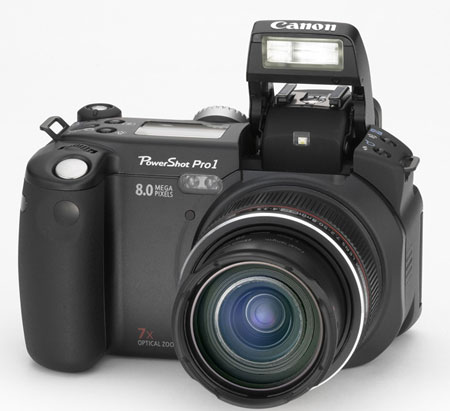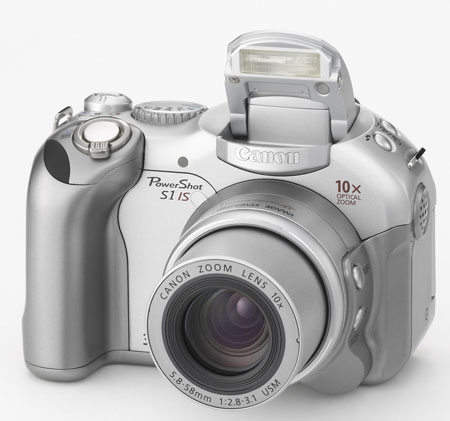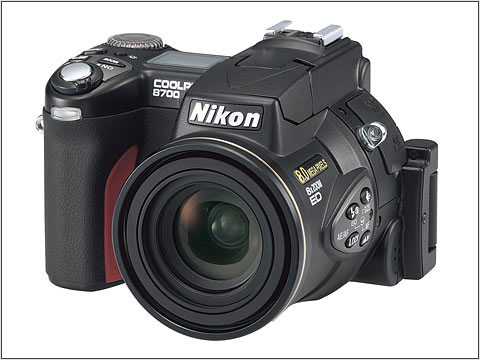 |
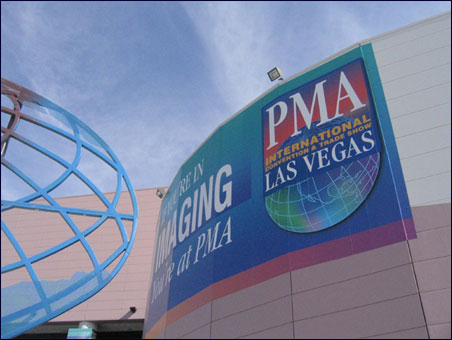 | |
SPECIAL REPORT: THE CAMERAS OF PMA
March 2004
|
 |
|
Digital Photography is no longer special. It now is photography. This year's convention of the Photographic Marketing Association in Las Vegas, the annual industry rollout of new products firmly established that digital has now crossed over to become the dominant factor. For all effects and purposes, film is dead. In 2003, digital crossed over the declining market share of traditional cameras and then kept climbing. By the end of the year, 31% of U.S. households owned digital cameras. Digital cameras outsold film cameras at the rate of 12.5 million digital units versus 12.1 million film cameras. This gap is expected to widen in 2004 with 15.7 million digital cameras expected to be sold, compared to 10.5 million film cameras (source PMA) At PMA, everything was about digital workflow. The major manufacturers all introduced turnkey items that would enable the photographer, whether they were professional or amateur to control the entire production process from acquisition to printing. Printers, for example, were featured that could produce finished photographs without the need for a PC interface. What was interesting to photographers was who wasn't exhibiting. The major medium-format companies, Hasselblad and Mamiya, did not have booths this year. This reflects the quickly declining fortunes of these formerly prestigious manufacturers. Both have been severely wounded as high-end photographers have found that art directors, who used to treasure the quality of these larger format cameras, are now happier to get instant photographs on their computer screens, which allows them to evaluate how successful shoots are, even as the session is still going on. With 8 mega pixel files from 35mm cameras, there is no longer an advantage to the large format. One of the most interesting developments was the emergence of the$999 cameras. Most major manufacturers, including Canon, Nikon, Sony, Panasonic and Olympus featured versions in this price range that are marvels of technology. These cameras, intended for the "prosumer" buyer also had appeal to the professional as a "backup" camera to be used as part of their kit. Canon and Nikon were also intent on capturing budget-minded professionals and advanced amateurs with new low-cost versions of their flagship products. Overall, the versatility of these new products was mind numbing, and it is clear that all manufacturers were out to come up with more "value-added" features in their cameras. Here is a look at some of the new products we saw in the 3 days, stalking the miles of floor space at the Las Vegas Convention Center: THE HIGH END: Canon. Nikon and Olympus all featured their new top of the line systems. Canon showed their new EOS ID-Mark II, that our David Drapkin reviewed last month (Using the Canon EOS1-D Mark II at the Super Bowl ). Canon claims that it is the fastest professional DSLR. It features a 8.2 million pixel CMOS sensor, and can shoot up to 8.5 fps in 40 continuous frame bursts. The camera sells for $4,499 and will be available in stores in April.
Nikon featured its high-speed counterpart to the Mark II, the D2H. See Chick Harrity's review in this issue. Olympus was very much in evidence with its new E1 system, which marks the emergence of this company as a professional resource. See Eli Reed's review of this product. THE BUDGET PRICED"BIG" CAMERAS: One of the interesting trends is to see how manufacturers have come up with lower priced versions of their flagship cameras, in the interest of attracting prosumers, advanced amateurs and pros who want backup cameras for their high end models, that use all the same lenses and accessories.
Canon was showing their 10-D, which was introduced last spring, with its 6.3 mega pixel sensor. This camera really established the standard for quality at a budget cost of $1,400. Now it's Digital Rebel little sister takes that same 6.3 mega pixel resolution and puts it into a cheaper body, with a high-speedWide-area 7 point AF with superimposed focusing points. It uses all the standard Canon lenses, and comes in at about $899 for the body only. THOSE AMAZING $999 CAMERAS The big news of the show was the proliferation of models from all the manufacturers of self-contained systems (body and lens in one unit), that had all the reach and versatility of professional lens and body systems, and which sold for a common price of $999. These cameras offer value-packed features that make them ideal for prosumers, advanced amateurs, students, and as auxiliary cameras for pros. Some of them are rugged enough to serve on the battlefield. Let's start with the SONY CYBERSHOT F28. Sony has a lion's share of the prosumer digital camera market. This sleek camera features an ultra-sharp 7x optical zoom. F2.0-2.8 28-200mm. lens. Here is a good place to mention one of the big advances that most manufactures have made in lens design. Traditional lenses have different coverage patterns on digital, due to the reduced size of the frame that must be covered. This means that optics can now be made smaller yet offer higher zoom ranges. Also, the manufacturers of this class of cameras are keeping the habits of photographers in mind in their design. This translates to lenses that actually have zoom and focus rings, rather than buttons on the body that perform these functions. This is reassuring to a traditional photographer brought up on 35mm.
A memory stick allows you to store images as JPEGS, TIFFS and/or RAW, and the new Memory Stick PRO media card allows you to exponentially increase saving and transferring options. It also has dual media slots, which allows for saving to a variety of media formats, including flash cards. All in all, this is an awesome camera. OLYMPUS C-8080 DIGITAL CAMERA Olympus, which introduced its E1 professional system last year, made a very strong impression with its8080 Digital. This 8-mega-pixel camera, which sells for $999 features a "wide angle" zoom that covers an equivalent of a 28-140 mm zoom. Olympus also offers a wide-angle converter for the camera that makes it look awesome, and takes the range down to a 21mm lens. The camera also features a new engine, allowing it to process images quickly.
One of the problems with LCD screens on digital cameras is that it is often difficult to see the image in bright light. Olympus offers a new super-bright screen to offset this drawback. Ten shooting modes include Manual, Automatic, Creative scene, and customizable "my mode" settings. It also includes a Quick Time Movie mode with audio, dedicated hot shoe and a magnesium alloy body. The C8080 is PictBridge enabled, features USB auto-connect and has a dual media slot accepting XD picture card and compact flash cards. Olympus expects to start delivering this camera in March. This is a great second camera for pros, and should be considered by Universities as low-cost digital camera for use in courses. THE CANON POWER SHOT PRO Another camera that Universities would do well to consider for their photojournalism courses is the new Canon Power Shot Pro. The manufacturer has upgraded the Power Shot line moving into a more traditional SLR housing. It features a bright electronic viewfinder that allows for quick composition without annoying"frame shifts" at the longer lens settings. The 8-mega-pixel camera features a 28-200 effective zoom, with an f2.4-3.5 f-stop. There is a pop-out LCD screen on the back of the camera, that allows for low angle and "hail mary" shooting. It captures video at 15fps, and can deliver 30 seconds of high quality video, or 3 minutes at reduced resolution. It has a new lithium battery that can power 420 shots. This $999 camera will be in stores in late March or early April.
Although the Power Shot Pro is the most impressive of this category, it is worth looking into its lower-cost little brother, the Power Shot S1 IS. This 3.2 mega pixel camera sells for $399 and features a 10X optical zoom that provides a 35mm-380mm range. Most important, this camera features Canon's Image Stabilizer that makes handholding at the longer ranges practical. One of the interesting things about the SI IS is that its lower mega pixel range actually works to the benefit of its full motion, full length movies. The reason is that the higher mega pixel resolution of the 8-mega pixel cameras, cause problems with video capture. The camera has to essentially discard information that is not necessary for video. The 3.2 mega pixel standard is the perfect format for video capture. This means that rather than recording 30 seconds or 3 minutes as you can with the Power Shot Pro, you an actually record up to an hour-long movie on a high-speed CF card. Platypai should have this camera in their bag. As is the case of so many low-cost digital cameras at the show, the SI IS features a "plug and play" printing option which may be used with any Canon Direct Photo Printer or PictBridge supported printer. It gives the user instant complete control of the printing process right from the camera.
THE NIKON COOL PIX 8700 New this year is Nikon's first 8-mega pixel prosumer camera. The ergonomic design of this little camera is great. It feels like a real camera. It has an 8x optical Zoom-Nikon ED lens which provides the equivalent of a 35mm-280mm lens. It can shoot up to 5 full-size pictures at 2.5 fps. The start-up is very fast, with probably the least shutter delay of any camera in this category at 70 milliseconds. It has a new bright viewfinder, with a large vari-angle LCD screen on the back. The camera incorporates four exposure modes: Programed Auto, Aperture-Priority, Shutter-priority and full Manual. The 8700 also offers Auto mode in which the camera automatically selects appropriate exposures and shutter speeds, plus 12 versatile SCENE modes.
The 8700 features many advanced digital controls, such as BSS (Best Shot Selector), AE-BSS (Auto Exposure Best Shot Selector), Noise Reduction Mode, Saturation Control and White Balance Bracketing, plus a 5 shot buffer mode. It also features movie capability with audio and Time-Lapse Movie mode. New framing guides on the LCD monitor offer an optional means of achieving ideal composition, and the new real-time histogram display lets you select the best exposure value while shooting. The Cool Pix also offersRAW data image mode. The camera will be available in March. THE DIGITAL JOURNALIST "BEST IN SHOW" AWARD We've saved the best for last. As we have watched the avalanche of new digital cameras being introduced over the past few years, photojournalists, documentary photographers (and doctors and dentists) have had a recurring wet dream. When will there finally be a Leica Digital camera? Well, the answer is now. Both Panasonic and Leica have co-produced a digital version of this legendary camera, which was shown for the first time at PMA. Leica calls the camera the Leica Digilux 2, and Panasonic calls it the Lumix. They are identical, although the Panasonic version was shown as an all-black body, and Leica showed its model as a chrome housing.
The camera looks and feels like a Leica M camera. Leica fans will celebrate the fact that all the controls are right where they would be on a traditional camera. F-stops, focusing, and zoom for the 28-90 mm f2.0-2.8 Summicron lens is right there on the barrel. Shutter speeds and programming modes are on the familiar Leica dial. This is a 5-mega-pixel camera. When asked why they did not make it in an 8-mega-pixel mode, Leica produced 8x10 prints from competing cameras, and at 5 mega pixels the Leica seemed to have greater resolution. The reason, according to Leica and Panasonic, is that the Summicron lens offers superior resolution, with added flare protection. The camera is provided with a professional Leica lens hood. The electronic viewfinder compares favorably with the optical viewfinder on the traditional model, and a large 2.5" display on the back of the camera combines background illumination, as well as ambient light, which leads to enhanced brilliance, with exceptional contrast. The cameras are made with the high grade of magnesium that should outlast almost any camera on the market. It has something that no traditional Leica has: a built-in flash with a guide of 33 feet, or 15 feet in the wide-angle mode, and 13 feet in the 90mm setting. This flash does something that no other flash shown does, which is that it can be bounced for the candid look most documentary photographers prefer. Leica also makes an optional 24D flash unit, and even an underwater housing. The main difference between the Leica and Panasonic versions is that as usual, Leica charges more for that familiar logo on top of the camera. The Panasonic charges $1599 for its version, and Leica charges another two hundred bucks. Dentists and doctors won't care. They will gladly accept the higher price to be able to have the camera on their shelf. Leica does, however, offer a few extras with their package, such as an extended 3-year warranty, rather than Panasonic's one year, a 64 meg flash card, rather than a 32 Meg card, and a new special version of Photoshop with the camera. Leica now also nearly has digital back ready for its R8 and R9 reflex cameras. This means that the R series will be the world;s first true hybrid 35mm cameras that can be used optionally for digital or analog. As a lifetime Leica user, I can only tell you this is the camera I WANT. My guess is that dealers will have a problem keeping this great camera in stock. NAB REVIEW COMING IN MAY The Digital Journalist will be covering the National Association of Broadcasters show in Las Vegas in April. We will have a special report on all the new video cameras in our May issue.
© Dirck Halstead
Editor and Publisher of The Digital Journalist
|
|
|
Write a Letter to the Editor
Join our Mailing List
© The Digital Journalist
|

 Nikon unveiled the D70 as its lower cost entry at
$999. It is obviously aimed at cutting into the Canon Rebel
market. It looks and feels like a real Nikon, with a 6.1 Meg
chip. It takes all the Nikon lenses, but Nikon has added a brand
new lens to its line with his camera in mind, the AF-S DX
zoom-Nikor 17-55 mm f2.8. The pairing of the camera and the lens means
that the outfit can sell for $1200. The camera uses the same
"variprogram" that its high-end sister the D2H introduced,
which offers an extended range of special settings, including a
portrait setting, in which selective focusing is used to produce
pleasing portraits, and a night portrait setting. It also
incorporates the new D2H technlogy that makes it easy to do
multi-light wireless setups, using the SB800 and SB60 TTL
strobes.
Nikon unveiled the D70 as its lower cost entry at
$999. It is obviously aimed at cutting into the Canon Rebel
market. It looks and feels like a real Nikon, with a 6.1 Meg
chip. It takes all the Nikon lenses, but Nikon has added a brand
new lens to its line with his camera in mind, the AF-S DX
zoom-Nikor 17-55 mm f2.8. The pairing of the camera and the lens means
that the outfit can sell for $1200. The camera uses the same
"variprogram" that its high-end sister the D2H introduced,
which offers an extended range of special settings, including a
portrait setting, in which selective focusing is used to produce
pleasing portraits, and a night portrait setting. It also
incorporates the new D2H technlogy that makes it easy to do
multi-light wireless setups, using the SB800 and SB60 TTL
strobes.
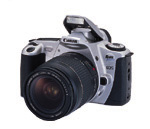
 The
cybershot is an 8megapixel camera. It features an easy to see
display of shutter and iris controls that show up in a colorful
active dial on the screen. A unique feature is that the control
back actually is on a pivot connected to the lens that allows the
photographer to make low-angle or "hail mary" shots
with ease.The camera features TTL and multi-pattern metering that
shows up as a histogram on the viewing screen with the flick of a
button. It also has a hologram auto focus that projects a laser
grid over the shooting subject during focus, even in little or no
light. This is coupled with a night shot and night framing
infrared system, that allows you to capture images in total
darkness, using infrared light, as well as establishing the
correct metering and focus before the flash captures a full color
image. In the burst mode the cyber shot will capture up to 7
frames each at 8-mega-pixel resolution in less than 2 seconds. In
its mpeg movie VX mode you can capture video at full frame
64-x800 resolution and 30fps.
The
cybershot is an 8megapixel camera. It features an easy to see
display of shutter and iris controls that show up in a colorful
active dial on the screen. A unique feature is that the control
back actually is on a pivot connected to the lens that allows the
photographer to make low-angle or "hail mary" shots
with ease.The camera features TTL and multi-pattern metering that
shows up as a histogram on the viewing screen with the flick of a
button. It also has a hologram auto focus that projects a laser
grid over the shooting subject during focus, even in little or no
light. This is coupled with a night shot and night framing
infrared system, that allows you to capture images in total
darkness, using infrared light, as well as establishing the
correct metering and focus before the flash captures a full color
image. In the burst mode the cyber shot will capture up to 7
frames each at 8-mega-pixel resolution in less than 2 seconds. In
its mpeg movie VX mode you can capture video at full frame
64-x800 resolution and 30fps.

